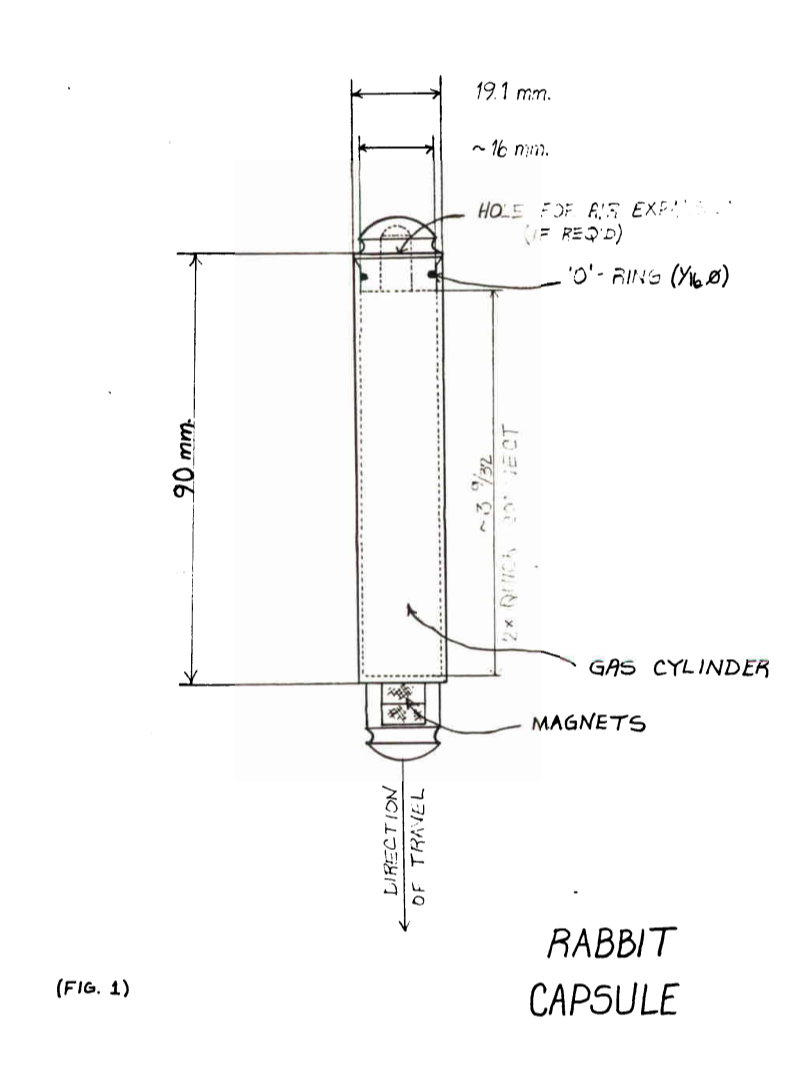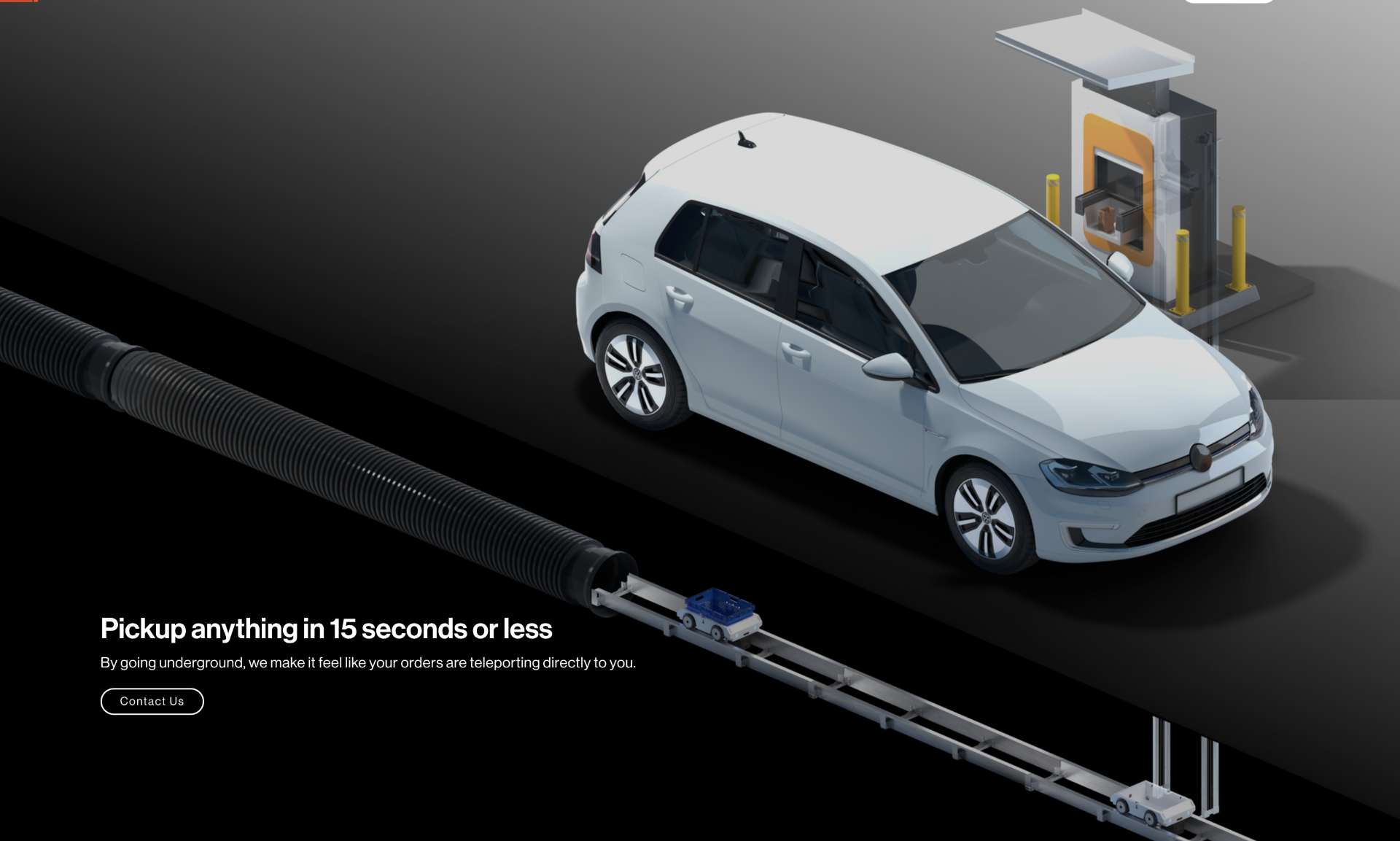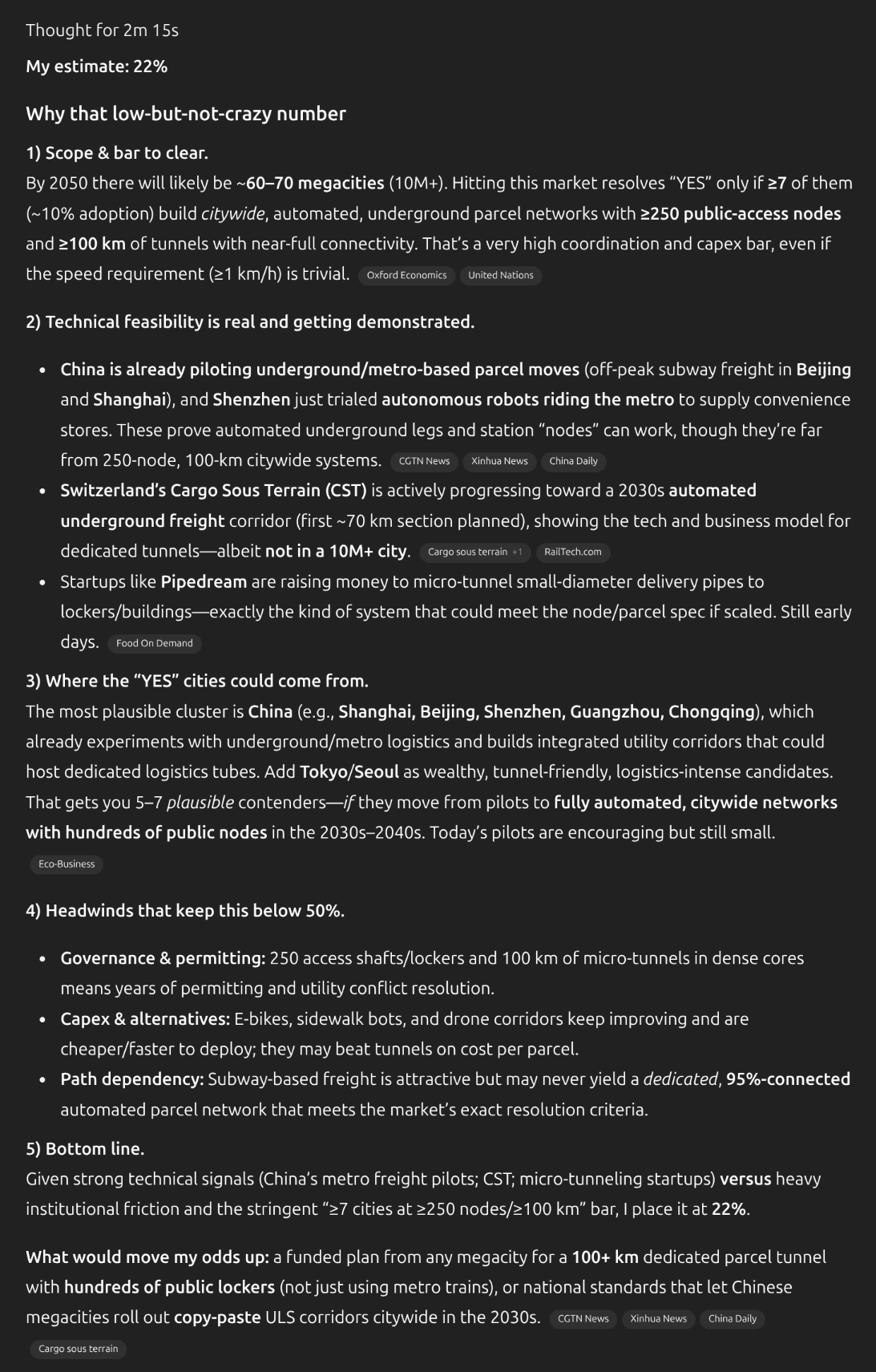
Resolves as YES if at least 7 major cities on Earth (of at least 10 million inhabitants each) have large-scale automated underground logistics networks before January 1st 2050.
In order to qualify, each network must include at least 250 nodes, and have a total length (take the sum of each underground point to point length between pairs of directly connected nodes) of at least 100km. A node is defined as a location where people can take or place packages into the network (on the surface, inside buildings, transport hubs...).
Only the automated sections of this network qualify. Each qualifying section must be able to transport packages of 10x10x10cm weighing 1kg at a speed of at least 1km/h in either direction.
A network of nodes is only considered to be a single entity if it is possible to send packages of the above description bidirectionally between at least 95% of every node-pair. If the automated network extends between multiple cities, then only the part of the network contained within one city is considered within the context of this question (must have at least 250 nodes of the "subnetwork" contained in the same city).
People are also trading
One concrete real world example of this sort of system may help people imagine what sort of undertaking this would entail.
The Rabbit Line is an underground air pressure powered capsule transport tube which goes from a particle accelerator lab called "TRIUMF" to The University of British Columbia Hospital, ~2.4km away.
Tom Scott did a video about it: https://youtu.be/eMTZvA8iFgI?si=zZqKDtDA-2vKpk6P
The capsules are smaller than the requirements for this question, plus the line is just a single one way connection. However, they built this thing to transport small amounts of short lived radioactive isotopes from where they are produced to where they are used as fast as possible. That ~2.4km is covered in ~2 minutes.

(From a 1982 design doc, they've since made some changes, but this is roughly what a capsule looks like)
If you just wanted to hook up a whole city with larger, heavier capsules, and you didn't need them to arrive as fast as possible or to contain radioactive isotopes, you could probably do that with much less expense per meter distance or per connection as the Rabbit line.
It certainly seems like a company one could start and get investors excited about, though there are some serious troubles with getting permits and ensuring that each new connection is sufficiently high ROI considering how much you may need to invest to tailor your engineering to each line.
It may also be that you don't want to use air pressure. If your primary concern is speed, then having smooth curves and using air pressure seems like the ideal way to do things, but how many gently curving lines can your draw under city streets without running into other infrastructure? I am unsure.

(From a 1983 design doc. These can be found by searching "Rabbit Line" on TRIUMF's website.)
The commercial version of this kind of system would likely be connecting nodes within the range of 1-5km. The 1983 design doc claims travel-time scales with Distance^1.5, under some other realistic-for-their-project parameters they did the calculations using. Maybe you don't particularly care if your package takes 6-7 minutes to travel 5km, but it seems likely that somewhere around there you start hitting some pretty substantial diminishing returns - if my vague guesses about what this would look like actually land in the right ballpark.
250 nodes? This seems plausible for a single city in 25 years. Perhaps you could even get up to 7 cities if your company continues to scale up connections per year past the average of 10 per participating city. Perhaps you start in Chicago, and in the first year you finish a network of 3 nodes, such that you can send stuff around in a triangle-like shape, then next year a bunch of other businesses along that triangle want "in on it" and intermediary nodes/branches take you up to +5-7 connections that year. Then, suddenly the price is dropping for a bunch of people near new nodes in your network, as distance to nearest node shrinks on average over the whole city and you've worked out some of the kinks and inefficiencies in your process, such that new nodes jump up to 15-20 per year.... Maybe then after like 15 years you've got a few hundred nodes all over the place, and are getting decent ROI in the sort of way any major utility in a city gets it when they've built out long lasting infrastructure and have their expenses cut to maintainance and operation.
Do 7 other cities also follow along quickly enough in that time period for this question to resolve "YES?" I'm somewhat more skeptical of this.
How quickly does local city governance take to copy innovations from other cities? Well, if this innovation happens in Singapore, possibly 7 cities get started on it within 2 years of each other... Otherwise? I sorta suspect that it'd take like 10 years for any other American city to pick this up, even if one American city does it and has huge success with it. One of my favorite critiques of our civilization is just how difficult and inconsistent it is for isomorphic areas of our species's efforts to end up resembling the most successful examples of those efforts. One port comes up with a shipping container handling strategy that improves efficiency massively? Well, everyone goes there and says "oooh, aaaahh, so amazing and brilliant" then they go to their home port and continue stacking containers the same way they have for decades (sometimes even as the underlying logistical problem changes over that time, as I believe was one of the reasons for supply chain failures on the West Coast of the US a few years ago.)
And healthcare, and tax structure, and public transport, and banking, and industry safety procedures... Etc. Etc. Etc.
There is a tradeoff here, heterogenous civilizations are probably less fragile in some ways. There will likely be more innovation, as a wider array of problems are getting addressed in specific localities. More homogenous civilizations are however "doing more of what actually works." Exploration vs. Exploitation.
But our civilization isn't really anywhere near the attainable optima of this tradeoff - IMO. We have a bunch of stuff that one place or another have done that look like really good ideas that solve a bunch of serious problems, and then everywhere else sees that and just keeps doing what they were doing before.
So, 2050? Maybe. This is one way to solve this problem that jumped to my mind, and maybe there's a way that's just so much cheaper and easier and fit-to-task that it happens way more rapidly and gets adopted way more broadly once someone actually starts doing it. But... I don't know, to me, this doesn't seem too likely?
<10%, is what I'm feeling about it.
However, maybe others will take the message of this comment more optimistically.

